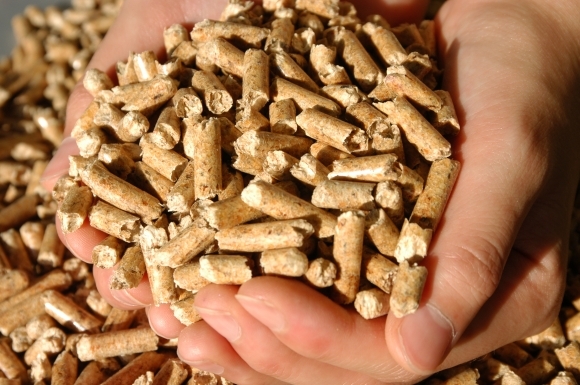A significant portion of South Korea’s renewable energy is generated by a controversial material that emits more greenhouse gas than coal, government data showed, raising concerns over the sustainability of the domestic green industry.
According to the Korea Energy Agency, compressed organic matter or biomass generated 6,620,283 megawatt hours of electricity in 2018, up 80 times from 83,015 MWh in 2012. Biomass accounted for 12.5 percent of total electricity generated by renewable energy sources in 2018.
Biomass, wood pellets which resemble corks and bio-SRF (solid refuse fuel) made of wood wastes, creates 112,000 kilograms of carbon dioxide per terajoule -- with one terajoule equaling 1 billion joules. In comparison, coking coal emits 94,600 kilograms of carbon dioxide per terajoule, according to the Intergovernmental Panel on Climate Change under UN. It is still considered a renewable energy source as it is produced from plant or animal material that can be recreated in a short span of time.
“Wood has less concentrated energy than fossil fuels, so a huge volume has to be burned to generate energy,” said Kim Soo-jin, a senior researcher from Korean environmental civic group Solutions for Our Climate.
Kim Joo-jin, managing director of the group and a former attorney at Kim & Chang, added, “When trees are cut down to manufacture biomass, it takes 70 to 80 years to offset the environmental effect as trees need that amount of time to regrow.”
Since 2012, electricity providers equipped with generation facility of 500 MW or more were given mandatory quota from the Ministry of Trade, Industry and Energy to provide a certain percentage of total electricity with renewable energy such as biomass and solar and wind power. The quota, or renewable energy certificate, which stands at 7 percent in 2020, will go up to 10 percent in 2023.
However, government’s overambitious quota system has triggered electricity providers turn to biomass due to its cost-effectiveness.
“Biomass costs very little initial investment because we can mix it with coal and use existing facilities in coal-fired power plants. The ratio of biomass is about 3 to 5 percent,” said Seo Dae-ho from Korea Western Power under Korea Electric Power Corp.
“In contrast, it costs about 1.5 billion won ($1.24 million) to install a solar power generation facility of 1 MW.”
Currently, in terms of the required REC, one is issued for every 1MWh generated by renewable energy. Any failure to meet the quota needs to be compensated with a “penalty,” which are done by having to purchase the RECs.
The government applies different weighted value on certain types of renewable energy in the name of incentivizing balanced growth of diverse renewable energy.
For example, when solar power generates 1 MWh by energy storage systems, REC worth 5 MWh is granted. In contrast, when biomass mixed with coal generates 1 MWh, no REC is given. This is because the government sliced weighted value on biomass dramatically starting 2018 to cut dependence on the fuel and to promote generating electricity with cleaner renewable energy sources.
Aside from more REC meaning less penalty, REC beyond one’s quota can be monetized by selling them to other electricity providers that fail to reach the 7 percent mark.
Ironically, the REC system, which was meant to promote the balanced growth of renewable energy and clean electricity, has been betrayed by its own ally: solar power.
According to the KEA, solar power generated 75,537 MWh in 2012. However, the figure jumped to 5,262,988 MWh in 2017, then exploded to 11,391,110 MWh in 2019.
Due to the growth of solar power, an oversupply of REC was created starting 2017. The amount of electricity generated by renewable energy exceeded the quota by 1,125,137 MWh, 769,929 MWh and 1,553,528 MWh respectively in 2017, 2018, and 2019. The oversupply of REC was more serious due to the weighted value, exceeding the quota by 3,068,089 MWh, 3,863,378 MWh and 8,069,600 MWh in the same period.
Following the acute oversupply, the REC price, which stood above 130,000 won in 2017, plunged to 35,600 won as of March 10, according to Korea Power Exchange.
“In a recent meeting with Korea Solar Energy Development Association, solar power operators expressed concerns as they are unable to recover investments as the oversupply has cut the REC price significantly,” said an official from the renewable energy department of the Trade Ministry.
However, not all electricity providers are bearing the brunt of nosediving REC price; in fact, some are benefiting from the drop.
“Lower REC price is a positive factor,” said a South Korean renewable energy solution provider that generates electricity mainly with LNG, citing the less burden of buying RECs at lower price.
Meanwhile, despite the government’s push to lower the dependence on biomass, the use remains rampant, mostly through the regulatory loophole.
“Though the government sliced weighted value on electricity generated by biomass starting June 2018, existing plants are exempted from the change, so there hasn’t been much change,” said an official of electricity provider GS E&S, which runs one biomass plant and has another under construction, which is also spared from the regulation as the construction began before June 2018.
By Kim Byung-wook (
kbw@heraldcorp.com)








![[Today’s K-pop] Blackpink’s Jennie, Lisa invited to Coachella as solo acts](http://res.heraldm.com/phpwas/restmb_idxmake.php?idx=644&simg=/content/image/2024/11/21/20241121050099_0.jpg)